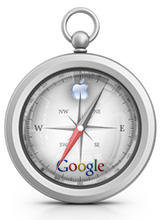A sense of vindication has most likely spread throughout the headquarters of Google in Mountain View, Calif., after reports surfaced that Apple’s new Maps app contained glaring imperfections, such as removing the Statue of Liberty from its perch in New York harbor. Apple’s decision to boot Google Maps from the list of pre-installed apps on the newest version of its mobile operating system, iOS6, replacing it with the company’s own error-prone version, no doubt only added to Google’s joy. Apple also kicked out another popular Google app, YouTube, in the same software update.
Here is the context for those who have not been following the Maps flap: Apple rolled out the new Maps-containing iOS6 on September 19 for installation on its devices. The operating system comes pre-installed in the latest smartphone, the iPhone 5, and is an update on older devices. By most reports, the iPhone 5 is the best-selling iPhone yet: more than five million in the three days after the device’s September 21 launch, or about one million more than the iPhone 4S in the comparable period a year ago. All of those customers will get Apple Maps as the default app. However, the app’s errors are almost comically glaring: Las Vegas is depicted as a melting city, train stations are placed underwater and some bridges show up crooked. A Tumblr page is dedicated to the program’s mishaps, andWired.com calls it a “mapocalypse.”
Mapping programs are among the most popular apps accessed on mobile devices and a key point of competition in the mobile arms race. According to Opus Research, mobile ads that appear on maps and location apps account for a quarter of about $2.5 billion spent on ads on wireless devices this year. That’s up from 10% in 2010, the research firm said. Among iPhone owners, Google Maps was the second most popular app used in March, after Apple’s iTunes store, online measurement firm comScore reported. With Android smartphone users, Google Maps was the third most popular, after the Android marketplace and Google Search apps.
Apple has good reason to resist ceding such a popular feature to Google, particularly since Android has overtaken iOS as the leading mobile platform. Today, Android is the top mobile operating system, claiming 51% of the smartphone market, according to an October 2 survey by comScore. Apple is second with 31.9%. Technology news site AllThingsD reported that Apple jettisoned Google Maps in part because the two companies could not come to an agreement over providing voice-guided turn-by-turn driving directions for iOS — a feature that is available to Google Maps users on the Android platform. Sources familiar with the negotiations told AllThingsD that Apple leadership was unhappy that Google was trying to call the shots on such a key application, while Google was leery of providing voice-navigation without getting more control and greater visibility on the app — something Apple was unwilling to provide.
The acrimony between Apple and Google is well known. In the biography of late Apple founder and CEO Steve Jobs by Walter Isaacson, Jobs accused Google of stealing the idea behind Apple’s operating system and coming up with Android. “I will spend my last dying breath if I need to, and I will spend every penny of Apple’s $40 billion in the bank, to right this wrong. I’m going to destroy Android because it’s a stolen product. I’m willing to go to thermonuclear war on this,” Jobs said in 2010. At the time, Apple had just sued phone maker and Android user HTC for alleged infringement of its patents on multi-touch features. The lawsuit was one of many that the Cupertino, Calif.-based firm has lobbed at companies with phones that run on Android, and it is widely believed that Google is the true target of such moves. In August, Apple won a patent infringement lawsuit against Samsung, whose Android smartphones are outselling iPhones worldwide, and was awarded damages of $1 billion.
For Apple, “it’s a good strategy to develop their own mapping service,” says Wharton operations and information management professor Shawndra Hill. “It’s a key component on everyone’s smartphone.” Although Apple Maps appears to be a deficit right now, it’s likely to become an asset as time goes on and the company is able to work out the glitches, notes Wharton marketing professor Peter Fader, who is also co-director of the Wharton Customer Analytics Initiative. “This is such a non-issue. Google Maps isn’t perfect. If people scoured Google Maps as carefully as they scoured Apple’s Maps, they would find things that are not quite right,” Fader points out. “For the vast majority [of iPhone users], it’s fine. They know it’s early in the game and it gets better. If people want Google Maps, they can access it. It’s not that [Apple] blocked Google Maps; it just doesn’t come pre-installed. People will forget about this. This is nothing compared to ‘antenna-gate.’ Even that is entirely forgotten.”
Fader is referring to a 2010 incident in which a faulty antenna design in the iPhone 4 caused degraded reception. Apple had wrapped the antenna around the device to minimize size, but users gripping the phone encountered signal interference. The tech company ultimately gave away plastic bands that go around the iPhone and sent out a software fix. In many cases, early adopters of new tech devices are more forgiving of glitches because “they expect the brand-new model to be kind of buggy,” Fader says, noting that the same cannot be said of other consumer products, such as movies or books, that have to do well at launch because sales can quickly tank.
When Jobs apologized for the faulty antenna, he was criticized for pointing out in his comeuppance that rival smartphones had similar issues. In a statement addressing the problems with the Maps application, current CEO Tim Cook advised iPhone owners to seek out other mapping programs, suggesting downloads of MapQuest, Microsoft’s Bing and yes, Google Maps, until Apple’s mapping program improved.
Who Wins — and Who Loses
In the flap over Maps, both Apple and Google are winners — and losers, Wharton experts say. In the short run, Google — where developers hope to finish a maps application for iOS devices by the end of the year — is losing direct access to millions of iPhone users. Meanwhile, the iPhone 5 continues to enjoy robust sales despite the bad press for Apple Maps.
Google Maps will no longer be as easily accessible on iOS devices, including the iPhone, iPad and iPod Touch. When users search for directions within another app that involves maps — Yelp, for example — it will link to Apple Maps. To get to Google Maps, one has to separately access it through a search engine and retype the address being sought. If users decline to take those extra steps, Google stands to lose any benefit associated with tracking their whereabouts. Thus far, around 100 million people have downloaded iOS6, according to Apple.
The good news for Google, however, is that Apple’s latest moves could cast a permanent stain upon its corporate character. “The one silver lining is that Google looks like a victim here, and Apple looks like a bully,” Fader says. “From a public relations standpoint, Apple [appears] evil and greedy” for kicking out Google Maps, a popular app beloved by users. “I do think Apple made a mistake. It was dumb for them to walk away from Google just for more or less political reasons. I don’t think it was for a good business reason. A lot of it was posturing on their part, trying to send signals to Google and to the consumer that we [Apple] are self-sufficient.”
Whether Apple booted Google for personal or business reasons, or both, it took a risk by rolling out a flawed product. But its saving grace is that maps, though important, is only one of many features of iOS6. According to Eric Clemons, a Wharton professor of operations and information management, a company can usually get away with rolling out an inferior product if it is bundled with other applications and if it takes effort for consumers to switch to an alternative. When Microsoft introduced its Excel spreadsheet program, for example, it was widely considered to be inferior to Lotus 123. But the software got a boost by being bundled into a suite of other programs, Clemons notes. In the same way, most iPhone users will likely put up with Apple Maps because they like many of the phone’s other features. “No one is going to abandon an iPhone for Android just for that reason,” Clemons says.
The Value of Maps
Apple may have stumbled out of the gate, but it is a fallacy to think that Google Maps cannot be overtaken, Clemons suggests. “Do you remember when no one was expected to be able to catch MapQuest? Google can be caught.” To be sure, Google has a good lead: Its StreetView cars mounted with cameras already have driven five million miles recording streets and landmarks to be incorporated into Google Maps, according to a September 6 article in The Atlantic. In a statement addressing the loss of the application from iOS, the search giant described Google Maps as “the most comprehensive, accurate and easy-to-use maps in the world. Our goal is to make Google Maps available to everyone who wants to use it, regardless of device, browser or operating system.”
So why did Apple dump Google Maps? David Pogue, The New York Times personal tech columnist, wrote in a September 26 article: “Every time you use Google’s maps, you’re sending data from your phone to Google. That information — how you’re using maps, where you’re going, which roads actually exist — is extremely valuable; it can be used to improve both the maps and Google’s ability to deliver location-based offers and advertising.” Pogue noted that Google was not supplying the iPhone with some of the most important features in its maps that it was giving to Android phones, such as spoken navigation. That is why, when their contract renewal came up, Apple simply said “no,” Pogue wrote.
Meanwhile, consumers voiced their displeasure quite loudly online. “There is a big outcry for a variety of reasons. Google is popular. Google also, I suspect, has an army of semi-official groupies who raise an outcry any time Google is disadvantaged by anything,” Clemons says. For its part, Apple has stated that as more people use its maps, accuracy will greatly improve given that location searches are tracked. “There are a few things they could do that would make it better, involving small changes to the interface to make it consume less bandwidth at the start and to make it easier to specify that you wanted to navigate from your current location to someplace,” he suggests. “Apple Maps does not need to be much better [than Google Maps]. It just needs to be as good and properly integrated.”
Apple is accomplishing two things by kicking Google out, Clemons notes: “It is protecting the privacy of its users, which could be a source of competitive advantage, and it could be denying Google detailed information on the activities, location and interests of its users, which could be another source of competitive advantage.” Maps, while a popularly used feature on smartphones, are “not a killer app for users, but a Trojan horse for data parasites like Google,” Clemons says.
If Apple pledges not to track users, it could lure many more people from Google Maps, even if its maps are not perfect, according to Clemons. “Apple can say, ‘Our map respects your privacy.'” Google makes most of its revenue on advertisements so it is critical for them to track users, he adds, but the company has been taken to task for privacy violations. “Google sends ads based not just on searches, but on everything you do online.” In contrast, Apple derives the bulk of its business from sales of Mac computers as well as iPhone, iPad, iPod and iPod Touch devices. Thus, the company is in a financial position to forgo ad revenue opportunities and possibly gain some consumer goodwill in the process, Clemons notes.
Indeed, while people’s attention was focused on maps, what may have been overlooked are the enhanced privacy features in iOS6, according to an October 1 article by the Center for Democracy and Technology. “When iOS6 was released last week, the ‘big news’ was Apple’s decision to drop Google Maps. In the uproar that followed, iOS6’s privacy features received little fanfare, despite undergoing a major overhaul,” the group said. “Many changes [that the center] has advocated for — including giving users more control over tracking and increasing the visibility of options in the privacy settings — have been adopted in the new version.”
But ultimately, the total ecosystem is what corrals people to a particular smartphone, experts say, whether it is iOS, Android, Windows Phone or others. An owner of several Apple devices would be hard-pressed, for example, to switch to Android because many of his or her devices use iTunes and operate on iOS. “The biggest key to mobile supremacy? It has less to do with the particular apps within an ecosystem, and more to do with the size of the installed base using it,” Fader says. “Google/Android has an obvious advantage here because they work with so many manufacturers. Apple is unlikely to be able to match their footprint in the long run. That’s the key. The size of the footprint drives the apps, not the other way around.” In the end, he adds, “that’s where the battle will be won or lost.”



